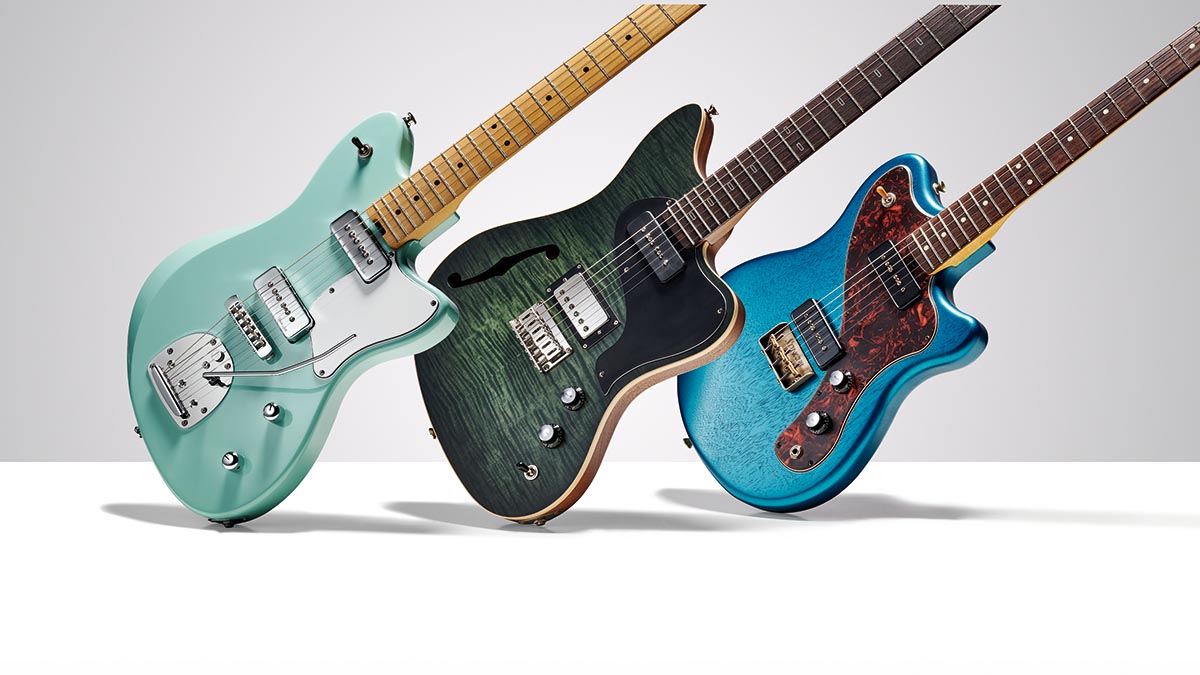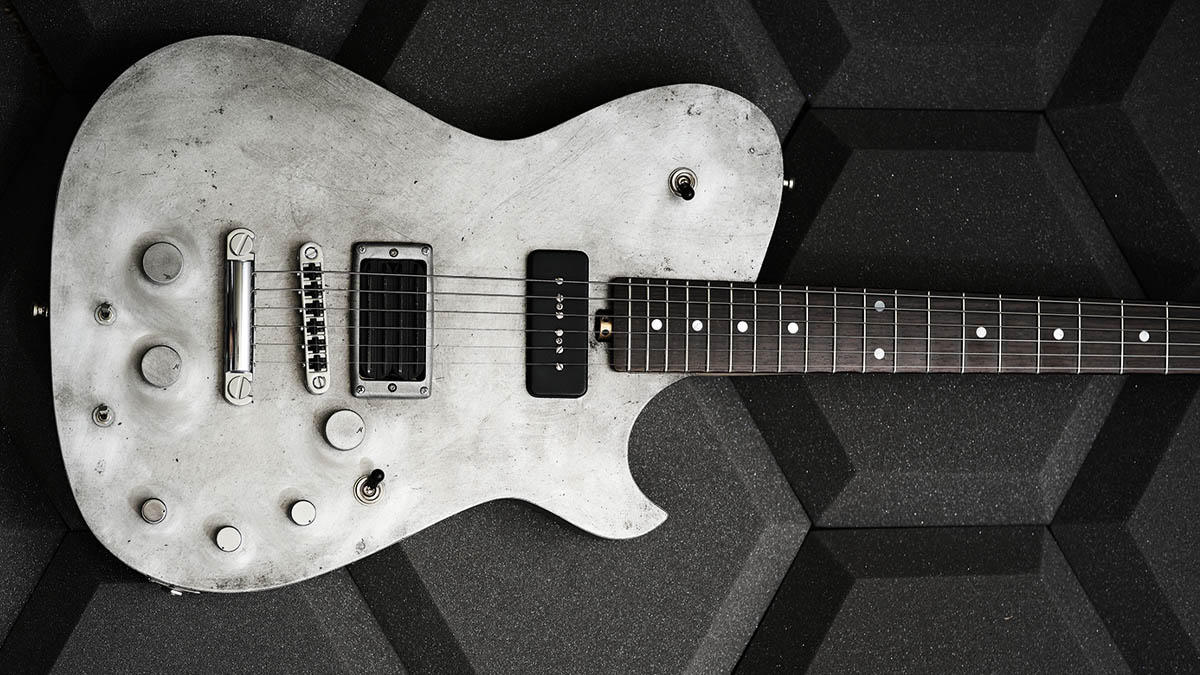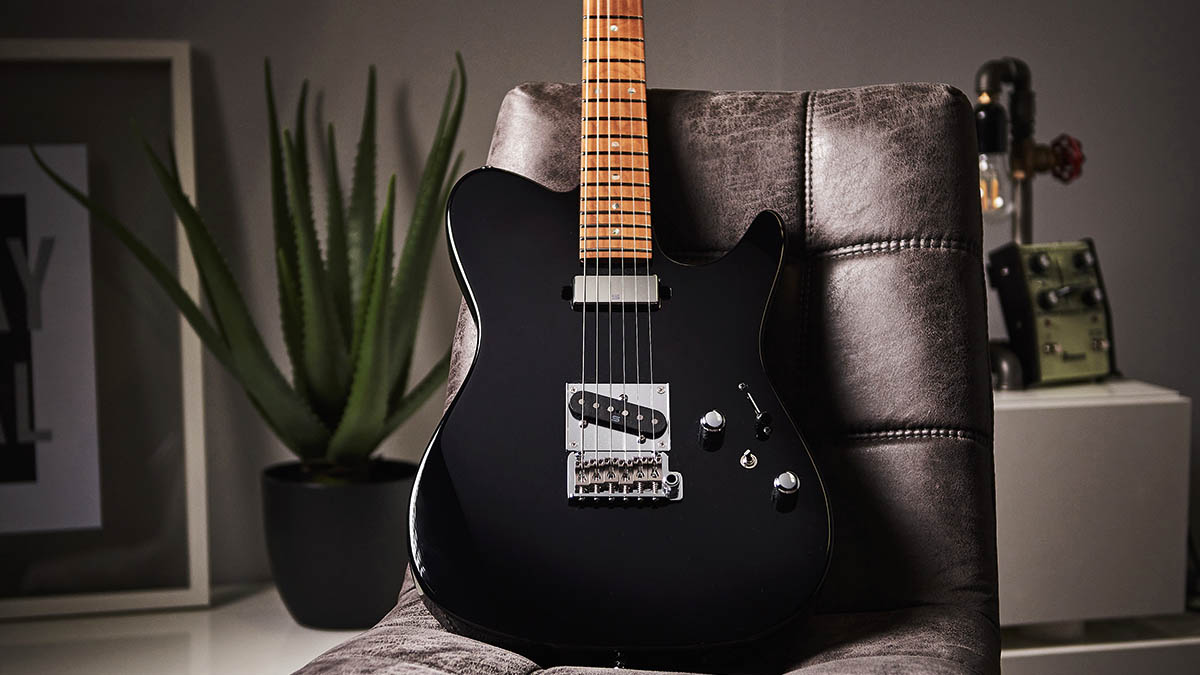Why guitar design is undergoing a renaissance in the wake of the pandemic
Supply chain issues and the drive for sustainable production are changing the way gear is made, but, as ever, it is ultimately the players who are steering where design is going next

Sometimes guitar design seems to evolve as slowly as a maple tree grows, little by little, with deep roots in tradition. But every now and then a storm comes along that uproots settled ways, and we are in the midst of such a time now.
The good news is that players are getting better and more highly developed guitars than they’ve ever had before – regardless of genre.
In the following feature, we examine why guitar design is undergoing a renaissance in the wake of the pandemic, rounding up the best of 21st century lutherie and talking to some of the prime movers in guitar innovation about the new wave of guitar and what it means for players everywhere.

It’s become a cliché that guitarists don’t ‘do’ progress. Certainly, there’s no denying that battered Tweed amps and old Les Pauls are magical things – and there’s a reason they’re still benchmarks for a certain kind of tone and a certain kind of player. But, as we emerge slowly from the pandemic, there are signs that a genuine renaissance in guitar design is happening – and that it’s being driven by player demand.
The pandemic has played a role in that. Prior to the world locking down for a year, webcasting and using social media as the main outlet for your music was just a rising trend. Now it feels central.

Other norms are crumbling, too. It used to be that only flawlessly black ebony passed muster on a fingerboard, but now players are hip to figured ebony. That’s partly because it’s a less wasteful choice in a world that’s running out of natural resources – non-black ebony used to be left to rot in forests if a tree was felled and found to contain ‘inferior’ figured wood inside – but it also looks great.
Mexican-built Fenders now come shipped with pau ferro fingerboards, not rosewood – and to be fair not everyone likes the look of that – but the sky hasn’t fallen in yet and it does the job well. Taylor is making guitars out of trees harvested from city streets that would otherwise have been made into garden mulch. The times they are a-changing, to be sure.
All the latest guitar news, interviews, lessons, reviews, deals and more, direct to your inbox!
Some of the changes in how guitars are being made are due to longterm issues, including depletion of natural resources. Others, such as supply chain logjams, are short-term consequences of the pandemic. But, as terrible as it has been in most respects, the pandemic also persuaded large numbers of people to take up the guitar for the first time.

Andy Powers, master luthier at Taylor Guitars, says this sudden influx of new players is a huge deal and will have lasting consequences for the guitar industry.
“It would be impossible for us to ever go back to what we once thought of as normal now,” Andy reflects. “Within the music world, changes are always driven by players – or maybe I should say that the acceptance of changes is driven by players. And so when you look at the guitar world, you now have a larger set of potential players active at any one time: you have people that you would call baby boomers, you have people you’d call millennials.
“You have the kids of millennials… you have a big swathe of the population who are now all interested in playing guitar and all active at the same time. And while that’s going on, you have a wider range of styles, genres, repertoire, technique and ways to use a guitar than you ever have at any one time.
Within the music world, changes are always driven by players – or maybe I should say that the acceptance of changes is driven by players
Andy Powers
“There used to be a fairly small, very narrow way to use a guitar and it would get shifted from season to season,” Andy continues. “Let’s say if you were making music, it was a fairly predictable avenue: maybe your success was defined as ‘playing guitar in a band on a record that was receiving radio airplay’. Well, that’s not the case now.
“You might find you have an audience for your music via YouTube, via a social media channel or some outlet that way. It might be in traditional records. It might be in a live-only, small-community setting where you have a regular following and people want to go to a coffee shop to hear this one musician every week do their residency. There is a nearly infinite number of avenues for somebody to be making music.”

Growing numbers of people taking up guitar plus a huge expansion in guitarists using social media to reach their audience is already changing the landscape of guitar design, Andy argues.
“There’s such a fragmentation going on. There is no clear, single path for a guitar player to be using their guitar any more. And I think that’s wonderful because it’s a far more inclusive musical environment than it ever has been. So, at the same time, you have a larger swathe of the population interested and active in playing guitar.
“You have a wider number of outlets for people to share and participate or interact with their music. And you have an appetite for more unique, different kinds of sounds to fit in these different environments. So, to me, it feels like this perfect storm that’s a new lift-off era for the guitar itself.”
Bringing it all back home
That lift-off effect is not limited to American makers, either. For example, Britain has always produced great custom-built electrics. Now the UK seems to have two makers, in Gordon Smith and PJD Guitars, that are building high-quality electric guitars in significant numbers and for a price that makes them a mass-market proposition.
These guitars are not ungainly oddities, either – they look and sound as good as anything built across the pond. With post-pandemic shipping prices from China and Indonesia rising ever-higher, suddenly building guitars closer to home is looking more attractive.

Guitar makers have found themselves in an economic hall of mirrors where guitars that were once far cheaper to produce overseas are now, in some cases, viable to build at home – with no international shipping delays to contend with, either. Amp maker Laney, for example, recently brought production of its Lionheart amps back to the UK.
We have started the process of moving the full production of Auden into the UK... With the world’s current global supply chain difficulties, it actually now makes economical sense
Doug Sparkes
Auden, a high-quality acoustic brand that is stablemate to Gordon Smith Guitars, has up to now done initial construction of its acoustics in China with neck-set and final finish being completed in Higham Ferrers in Northamptonshire. They’re now going to be built 100 per cent in the UK.
“We have started the process of moving the full production of Auden into the UK from the Far East,” says Auden and Gordon Smith owner, Doug Sparkes. “Currently, the wooden shell [unfinished body] is made in a small workshop in China. But with the world’s current global supply chain difficulties, it actually now makes economical sense to move into the UK.
“But at the same time, it’s also something I’ve always wanted to do so it’s sort of the last part of the jigsaw in terms of supporting British manufacturing, which, as you know, is something I’m really passionate about. So I’m really excited and pleased by it.”

The general situation is still volatile, however, and makers who have spread their bets between overseas and domestic production are best placed to cope, argues Adrian Ashton, CEO of Manson Guitar Works, the Devon-based brand that crafts Matt Bellamy of Muse’s futuristic stage instruments but also affordable modern electrics made in partnership with giant overseas guitar maker Cort.
“What we’ve seen in the last couple of years, I don’t think anyone could have dreamed up,” Adrian says. “And you’ve got to be ready to change and adapt to those conditions. Fortunately, we have such a mixed portfolio. We do have a guitar that is just over £500 retail, which is manufactured overseas.
“We also have a full-custom guitar that is manufactured totally in-house in the UK, and we have what I call our ‘production custom’, which is a mix of both of those elements. So when the market changes, if you have a flexible portfolio, you can adapt to those changes. If you’re stuck in one direction, you have to continue in that direction just to generate the funds to keep the company going.”

Adrian also echoes Andy Powers’ words about an explosion in the number of musicians who are using guitars in non-conventional ways.
“The guitar world has changed drastically in tune with the world,” he reflects. “It’s just fantastic that we’re seeing many, many more singer-songwriters with all sorts of backgrounds and diversity so it’s not just a trio or a quartet pounding out rock: it can be all these different styles and things merging together.
“Even if you just look at something like the hip-hop world, well, how do you make a guitar that’s relevant to that style of music? But with our MIDI screen, we actually do have an instrument that’s very relevant to that work. So diversity in design is important.
“Perhaps we’re not celebrated for it as much as for the crazier stuff we make, but we do make an MA guitar with just a bridge and a neck pickup and nothing else wild on it. But we also make the same guitar with a MIDI controller on it or a Fuzz Factory installed.”
Interesting times
So, what does this all mean for the evolution of guitar? Taking the above factors into consideration, it’s clear that there are some real themes developing in guitar design. Some small-volume makers are taking the best of the past and refining it, raising the craft to a new level of attention to detail and hand-built quality.
Good examples of that include makers such as Patrick James Eggle in the UK and Nik Huber in Germany or Suhr in the US. These brands aren’t about utility massproduction but handcrafting superlative instruments with classic roots in sufficient numbers to make the exercise much more than just a cottage industry. PRS has taken that concept and gone even further, becoming arguably the first ‘boutique’ mega-brand.
In fact, many major guitar brands are now looking to build guitars that meet the needs of players who want highly evolved features and performance in a classic-looking package. Ibanez’s AZ range is a great example of that, as is Fender’s new Mexican-built Player Plus line.

Interestingly, demand for such instruments at an affordable price point has been driven by players such as Guthrie Govan popularising guitars from the previous category – boutique high-performance instruments based on classic platforms. So AZ and Player Plus can be seen as mainstream outgrowths from the YouTube success of technically outstanding players who were no longer satisfied with ‘pointy headstock’ guitars to play their music, which has proven to be more soulful and eclectic than shred ever was.
These guitars are being made to a very high standard in serial production everywhere from the US to Mexico, Japan and Indonesia, meaning mainstream, premium-quality guitar making is now truly international.
Joining the big names in this enterprise are rising British makers such as Gordon Smith and PJD, who again aim to offer high-performance modern guitars that have classic roots. What sets the latter two brands apart is their proud determination to make as much as possible of their instruments in the UK – a move that is, for the moment, in step with the economic realities of our time.
Right now, shipping parts in from overseas can be costly and unpredictable, especially for growing brands that don’t have the financial might to simply wait out economic storms and have to be nimble and adaptable to survive. So those factors are driving a small renaissance in guitar making in this country, creating another trend.

Lastly, we have paradigm-shifting innovators, such as .strandberg and, in respect to at least some of their output, Manson Guitar Works. These brands cater to artists who want to use the guitar in entirely new ways. In the case of Manson Guitar Works, this might mean empowering the guitarist to control digital devices via the use of onboard MIDI controllers.
In the case of Taylor, on the acoustic side, it means making compelling guitars from unorthodox, sustainable tonewoods such as Urban Ash. Other makers still are looking closely at the rise of young, technically minded players who want to distance themselves entirely from the rock ’n’ roll roots of guitar.
“You’ve now got this new breed of player who really has a disdain for anything pre-1998,” comments Lee Wrathe, a stellar guitarist who’s well known for his official demos of Ibanez instruments. “You’ve got characters like Tim Henson, from the band Polyphia, referring to standard blues licks and bends as ‘boomer bends’. It really winds me up, to be honest with you! So you’ve got that and then you’ve got people who are creating music in a different way.
“There’s Ichika Nito, who is the Japanese signature-model artist for the new Ibanez Quest [headless guitars]. Ibanez, just like they did with the JEM and the RGs back in the 80s, have gone, ‘Okay, who is the next person we should be going to? It’s a new venture, exciting. Let’s go and find those players… We want to be capturing the hearts and minds of the followers of these new guitar heroes,’ if you like. So they’ve asked them the question: ‘What do you need?’
“The kind of music they play almost sounds like a music box. The way they tap on the guitar is almost piano-like. It’s a little like what Jennifer Batten would have done back in the day. The way they typically sit to perform also creates an angle on the guitar that means that their fretting hand is having to do different things, so Ibanez has gone, ‘Well, we’ll just angle the frets, then.’
“They haven’t gone, ‘Right, okay, we’ll just take a standard fanned-fret guitar and do that,’ because that would then change the scale length and all of that. They’ve kept it the same, but they’ve just angled the frets and worked out that an eight-degree slant is the one for them.”
Whether you like the almost avant-garde music being made by younger players who reject the blues lineage of rock ’n’ roll, there’s no doubt that it’s popular. Ichika Nito has 1.7 million subscribers on his YouTube channel and Polyphia’s geometrically intricate track G.O.A.T. has been viewed on YouTube 23 million times.
But look beneath the surface and there’s a further twist to the tale, as Lee Wrathe explains.
The lack of supply of certain parts has a knock-on effect in terms of what the design of the next guitar is going to be...with the Quest guitars, we don’t see DiMarzio pickups in there. We don’t see Seymour Duncan… We see Ibanez pickups
Lee Wrathe
“When you look at the pickups of the Quest guitars, here’s the very interesting thing. One of the things that might factor into how new guitars are designed these days, in the current climate, is that the lack of supply of certain parts has a knock-on effect in terms of what the design of the next guitar is going to be.
“So with the Quest guitars, we don’t see DiMarzio pickups in there. We don’t see Seymour Duncan. We don’t see any third party pickups. We see Ibanez pickups in there, partly because they’re easier to get hold of. But they’ve done a wonderful job on them for their intended purpose.”
So here, at the bleeding edge of design, we find a world in which almost all the norms of guitar making in the 20th century have been turned on their head by logistics, economics and, most importantly, player demand. Interesting times, indeed.
Jamie Dickson is Editor-in-Chief of Guitarist magazine, Britain's best-selling and longest-running monthly for guitar players. He started his career at the Daily Telegraph in London, where his first assignment was interviewing blue-eyed soul legend Robert Palmer, going on to become a full-time author on music, writing for benchmark references such as 1001 Albums You Must Hear Before You Die and Dorling Kindersley's How To Play Guitar Step By Step. He joined Guitarist in 2011 and since then it has been his privilege to interview everyone from B.B. King to St. Vincent for Guitarist's readers, while sharing insights into scores of historic guitars, from Rory Gallagher's '61 Strat to the first Martin D-28 ever made.

